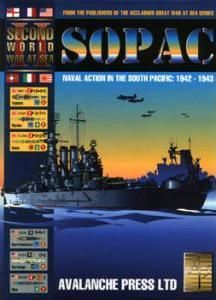SOPAC: Naval Action in the South Pacific 1942–1943 (1999) Board Game
Brief History and Background Information for SOPAC: Naval Action in the South Pacific 1942–1943
SOPAC: Naval Action in the South Pacific 1942–1943 is a board game that simulates naval battles that took place in the South Pacific during World War II. Designed by Peggy Coleman and Brien J. Miller, the game was released in 1999 by Avalanche Press Ltd. Players take on the roles of naval commanders from the United States and Japan, strategizing and making tactical decisions to outmaneuver their opponent in the Pacific theater.
Game Components of SOPAC: Naval Action in the South Pacific 1942–1943
- Hexagon grid game board
- Naval unit counters
- Dice
- Rulebook
How To Setup SOPAC: Naval Action in the South Pacific 1942–1943
- Place the hexagon grid game board on a flat surface.
- Each player selects their naval unit counters and places them on the designated starting positions.
- Roll the dice to determine the starting player.
- Refer to the rulebook for specific setup instructions and gameplay rules.
Gameplay Mechanics and Game Objective
The gameplay of SOPAC: Naval Action in the South Pacific 1942–1943 revolves around maneuvering naval units on the hexagon grid to engage in combat and achieve strategic objectives. Players must carefully plan their moves, considering the strengths and weaknesses of their units as well as the overall battlefield conditions. The objective is to outmaneuver and defeat the opponent’s naval forces to secure control of the South Pacific.
Player Experience
Pros:
- Engaging strategic gameplay that rewards tactical thinking
- Historical accuracy in depicting naval battles of World War II
- Hexagon grid adds a unique element to traditional wargame mechanics
Cons:
- Steep learning curve for new players
- Lengthy runtime may deter casual gamers
- Limited replay value due to fixed scenarios and outcomes
Personal Thoughts on SOPAC: Naval Action in the South Pacific 1942–1943
As a fan of historical wargames, SOPAC offers a deep and immersive experience that captures the tension of naval warfare in the South Pacific. The game components are well-crafted, and the artwork by Avalanche Press Ltd. adds to the overall thematic immersion. However, the game’s steep learning curve and lengthy runtime may not appeal to all players. Overall, SOPAC is worth considering for those interested in World War II naval battles and strategic gameplay, but casual gamers may find it challenging to fully engage with.
Game Components of SOPAC: Naval Action in the South Pacific 1942–1943
How To Setup SOPAC: Naval Action in the South Pacific 1942–1943
Setting up the game involves distributing the task force cards, air strike cards, and other components according to the scenario being played. Players must carefully plan their naval and air strategies in advance, as the game requires a mix of long-term planning and tactical decision-making. Each scenario will have specific setup instructions to reflect the historical or hypothetical battle being simulated.
Gameplay Mechanics and Game Objective
Player Experience
**SOPAC: Naval Action in the South Pacific 1942–1943** offers a deep and immersive experience for players interested in naval warfare and World War II history. The game requires strategic thinking and tactical execution, making it appealing to fans of complex war games. Players must balance long-term planning with immediate tactical decisions, which adds a layer of realism and challenge to the game.
Pros
Cons
Personal Thoughts on SOPAC: Naval Action in the South Pacific 1942–1943
This game is ideal for enthusiasts of World War II history and naval warfare, as well as experienced board game players who enjoy complex strategic games. It offers a rich and detailed gaming experience that simulates the high stakes and tactical intricacies of naval battles in the South Pacific. However, it may not be the best choice for those looking for a quick or casual gaming experience.
We are supported by our audience. When you purchase through links on our site, we may earn an affiliate commission, at no extra cost for you. Learn more.

